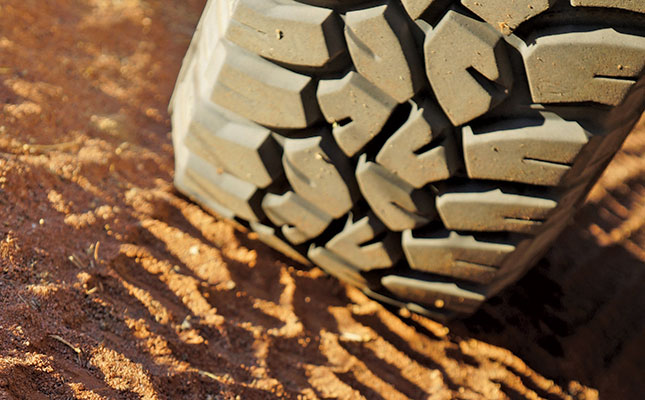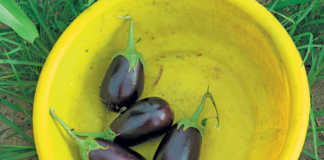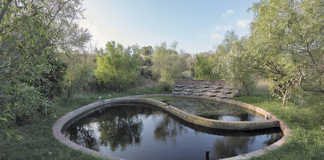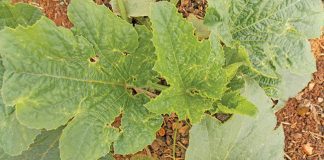
Photo: QuickPic
With such a bewildering choice available, buying new tyres for a 4×4 or a farm bakkie can be a nightmare. Even if you’ve made up your mind about what you want, it’s easy to get distracted from your initial choice by advertisements and special offers.
The ideal tyre
When considering the attributes of a good tyre, most motorists would put long life at the top of the list.
READ Choosing the ideal bakkie
But good grip during cornering and in the wet, as well as quiet running, are also desirable.
Unfortunately, a tyre that scores high marks in all of these qualities has yet to be made.
Soft rubber grips well, but wears down quickly; channels, cuts and tread blocks improve wet-weather grip, but reduce cornering ability on a dry road and tend to make a tyre noisy.
The best tyres are therefore a good compromise between the various desirable qualities.
Your owner’s manual is a good place to start looking for the best tyre. Motor manufacturers spend a great deal of time and money selecting tyres suited to the vehicle’s suspension system and performance levels.
It therefore makes sense to buy the brand and type of tyre recommended in the manual.
Nonetheless, there are sometimes slight differences between the original equipment tyre and the same aftermarket tyre.
READ Getting more mileage out of old tyres
The latest version might have been upgraded or restyled, for example. There are a number of reasons why the original tyre brand and type may not be ideal for you:
- You may no longer have the manual, and hence not know the specs;
- You may for some reason be unhappy with the standard tyres;
- You may wish to upgrade to a tyre that lasts longer, has better grip or possesses some other desirable quality.
With inferior tyres streaming into South Africa from the Far East, it’s better to stick to a well-known name rather than choose one you’ve never heard of. Minimise risk by buying only from an established tyre dealer.
Replacing tyres
Tyres should be replaced when the tread depth, measured at any location on the circumference, is less than 1,6mm, which is the legal limit in South Africa.
Most tyres have tread depth indicators, which are bars of hard rubber that become visible when the tyres are worn.
Tyres should also be replaced when there are obvious signs of damage on the tread or sidewall. This may be in the form of cuts or abrasions that signal the tyre is getting old.
When a tyre is more than six years old, it is no longer considered safe, even if it does not show signs of damage (see below).
It is also mandatory to replace a tyre that has been driven, even for a short distance, while completely or nearly flat. Such a tyre will have suffered internal damage that cannot be seen.
Tyre quality ratings
Each category of vehicle (passenger cars, sports cars, off-road vehicles, light commercial vehicles and heavy commercial vehicles) requires tyres with different characteristics.
Choosing tyres for a bakkie (a light commercial vehicle) is relatively simple, as the options are limited.
READ How old tyres can stop soil erosion in its tracks
Tyre manufacturers rate these tyres according to six qualities: wet grip, dry grip, mileage, noise, comfort and value. As mentioned earlier, no tyre can excel in all these characteristics, but most tyre company websites will give you enough information to choose a tyre that has the qualities you regard as important.
Budget tyres are usually of unknown quality, especially if the brand name is not well known.
Off-road tyres
The best off-road tyre for your bakkie depends to a great extent on what kind of off-road motoring you engage in.
Tyres suitable for off-road vehicles differ greatly not only in tread design, but also in tread and sidewall reinforcing. There are at least three classes of tyres to consider, with the result that you will only be happy with your choice if the tyres are suitable for your type of motoring.
- Multipurpose tyres
These are essentially designed for on-road use, but are suitable for occasional off-road use, provided you don’t go into sand or mud.
The tread often features slightly larger blocks than those on normal street tyres to improve grip during braking or accelerating on loose road surfaces. These blocks are normally siped (a sipe is a knife-edge cut) to improve traction on hard, wet surfaces. Fast off-road vehicles have these tyres fitted as standard because dedicated off-road tyres are seldom suitable for high-speed motoring. - All-terrain (50/50) tyres
These are designed for 50% on-road use and 50% off-road use. The treads are heavily grooved and the casing and sidewalls are reinforced to withstand the rigours of off-road motoring. They are noisier than street tyres. - Dedicated off-road tyres
These have large tread blocks, almost like those on tractor tyres, and offer the ultimate off-road performance. The casing and sidewalls are heavily reinforced and the tread depth can be as much as 17mm.
More care needed
Off-road tyres require more tyre maintenance than normal road tyres. They should be inspected after every off-road trip, as they can easily pick up damage that may cause a blowout weeks or months later.
Most manufacturers of full-time 4×4 vehicles recommend that you replace all four tyres at the same time.
You should also avoid mixing tyre brands, sizes and types, as all the tyres on the vehicle should have the same diameter. If this is not the case, excessive drive-train wear or even failure may occur.
Tyre markings explained
Modern tyres carry a DoT (Department of Transport) code on the sidewall that show the month and year of manufacture.
The code has four digits; the first two indicate the production week and the last two indicate the year, starting at the year 2000. For example, a tyre showing the code 4811 was built in the 48th week of the year 2011.
A tyre also carries a code that gives information on size, load rating and speed rating. The best way to explain this code is to use an example. So let’s take 225/55 R 17 97 W.
Here, 225 is the width of the tyre in millimetres, measured across the widest part, and 55 is the aspect ratio of the tyre; that is, the height of the sidewall expressed as a percentage of the tread width. In this case, the tyre width is 225mm and the sidewall height is 124mm, so the aspect ratio is 55% (124mm ÷ 225mm = 0,55).
R denotes that it is a radial-ply tyre, and 17 is the inside diameter of the tyre in inches. The number 97 indicates the load index, and its value can be read from a chart available at a tyre dealer.
It is the maximum load that the tyre can carry safely when inflated to its maximum safe pressure. The index 97 implies a load of 730kg/tyre.
W is the speed rating, and indicates the maximum speed at which this tyre can carry a
load safely. There are nine speed ratings:
Q = 160km/h; R = 170km/h;
S = 180km/h; T = 190km/h;
H = 210km/h; V = 240km/h;
ZR >240km/h; W = 270km/h and Y = 300km/h.











